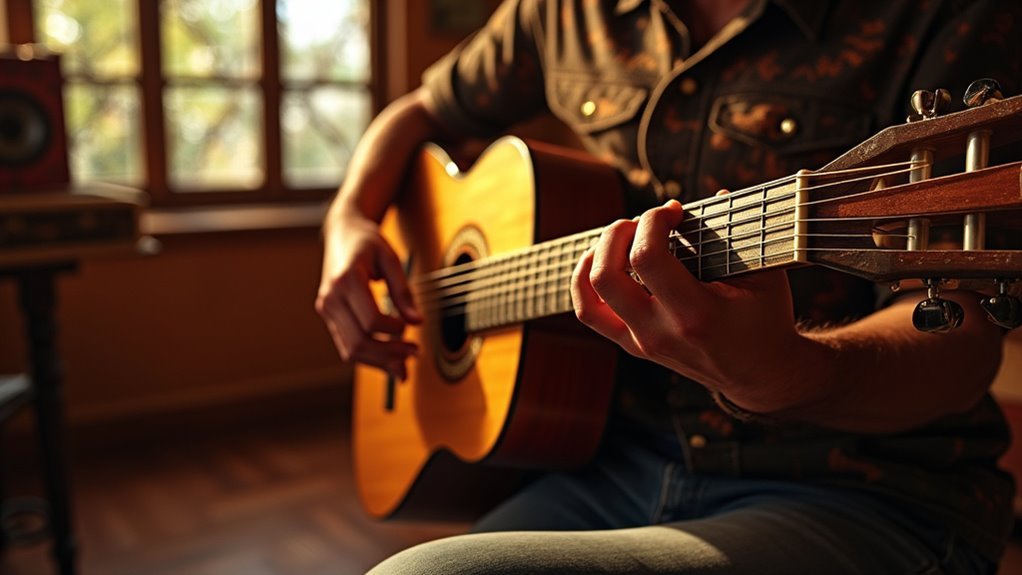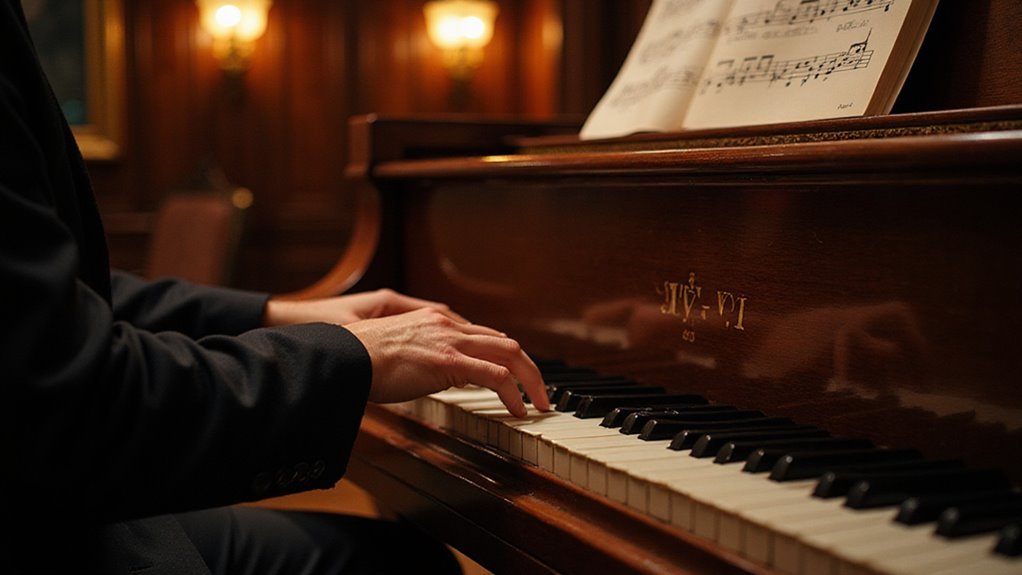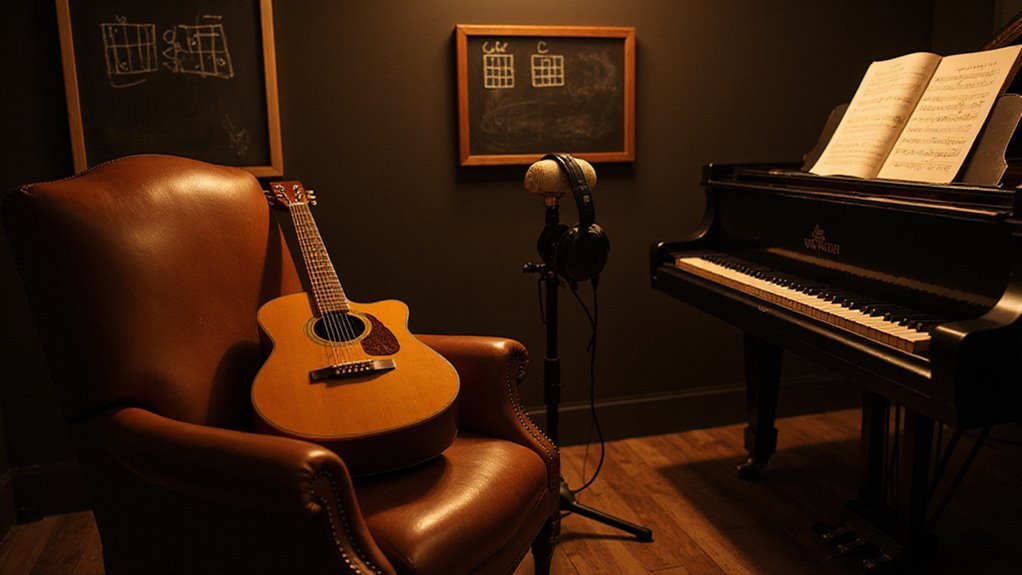Latin chords can transform ordinary compositions into rhythmic celebrations. Many musicians overlook these vibrant progressions, missing their potential to inject energy into almost any genre. The magic lies in their balance of tension and resolution—a musical conversation that practically demands movement. Perhaps it’s the cultural heritage behind these patterns that makes them so compelling. While some find Latin chord structures intimidating at first, their emotional impact makes them worth exploring. What happens when these fiery progressions meet your musical style?
The Fiery Heart of Latin Music: Understanding Core Chord Progressions

When delving into the world of Latin music, one quickly discovers that its heart and soul lie within its distinctive chord progressions.
These musical patterns create that unmistakable Latin feel that makes us want to move our bodies to the rhythm.
The most essential progressions—ii-V-I, I-IV-V, and I-vi-IV-V—form the backbone of Latin styles from salsa to bossa nova.
Perhaps what’s most fascinating is how these progressions blend tension and release, creating an emotional journey that feels both familiar and exciting.
Musicians who incorporate these progressions aren’t just playing notes; they’re connecting to a rich musical tradition that spans generations and cultures.
Mastering the Ii-V-I Progression: Your Gateway to Latin Rhythm

Nearly every serious student of Latin music encounters the ii-V-I progression as their first real challenge—and for good reason. This foundational sequence creates that distinctive Latin sound we all recognize, while offering a perfect balance of tension and resolution that feels somehow both familiar and exotic.
Musicians who master this progression reveal a world of improvisational possibilities. The minor chord (ii) builds anticipation, the dominant (V) heightens the tension, and the tonic (I) delivers that satisfying resolution we crave.
When you unlock the ii-V-I, you unlock music’s emotional heartbeat—tension, anticipation, and sweet release.
Perhaps it’s this emotional journey that makes the progression so universally appealing across cultures.
In Latin contexts, though, it’s the rhythmic application that truly transforms this progression into something magical.
Beyond Basics: Exploring I-IV-V and I-vi-IV-V Progressions

The ii-V-I progression opens the door to Latin music, but two other chord sequences truly define the genre’s accessible appeal.
The I-IV-V progression (think C-F-G in C major) forms the backbone of countless Latin hits, creating that infectious energy that gets people moving. It’s perhaps the most approachable pattern for newcomers.
Meanwhile, the I-vi-IV-V progression adds emotional depth through that vi chord. This subtle addition transforms a simple progression into something that feels more complete, I think.
Musicians often gravitate toward this sequence when they want to evoke both joy and a hint of melancholy—that bittersweet quality that makes Latin music so enchanting.
Adding Spice With I-Iv-Ii-V: the Latin Jazz Connection
Innovation thrives at the intersection of musical styles, and the I-IV-ii-V progression perfectly embodies this creative fusion. This dynamic sequence emerged when Latin rhythms met American jazz in the mid-20th century, creating something truly special for musicians seeking fresh expressions.
What makes this progression so fascinating is perhaps its unresolved tension—it leaves listeners wanting more. The tonal center established by the I chord flows through the IV, then dips into minor territory with the ii before the dominant V chord creates that signature Latin flair.
For those looking to belong to a musical tradition that balances structure with spice, I think the I-IV-ii-V might just be your new favorite progression.
Rhythm Matters: Infusing Authentic Movement Into Your Chord Play
Every successful Latin chord progression owes its infectious character to something beyond the notes themselves—rhythm serves as the heartbeat that brings these harmonic structures to life.
Without proper rhythmic emphasis, even the most authentic progressions fall flat.
Rhythm breathes life into Latin chord progressions—without it, authenticity remains merely theoretical.
The clave pattern, perhaps the most essential rhythmic foundation in Latin music, establishes a framework that guides both musicians and dancers.
When players accent certain beats within their chord progressions, they create that unmistakable groove that invites movement.
Mastering this rhythmic dimension isn’t just about technical precision—it’s about feeling the pulse.
Sometimes, I think musicians focus too much on chord theory while neglecting the physical, almost spiritual connection to rhythm.
Cross-Genre Applications: Latin Progressions in Pop, Rock, and Beyond
Musicians have long recognized that Latin chord progressions possess a remarkable adaptability that extends well beyond their cultural origins. The infectious energy of progressions like the ii-V-I and I-IV-V have found their way into countless pop hits, while rock musicians often incorporate the passionate I-vi-IV-V sequence to create emotional depth.
Perhaps most surprising is how these progressions blend seamlessly into genres you might not expect—from indie folk to electronic dance music.
Artists like Coldplay and John Mayer regularly borrow Latin harmonic structures, proving that these chord sequences transcend boundaries. They connect with listeners on an instinctive level, regardless of the genre wrapper they’re presented in.
Emotional Storytelling Through Latin Chord Sequences
When exploring the emotional landscape of Latin music, chord sequences function as a sophisticated language that conveys feelings without uttering a single word. These progressions tell stories that perhaps resonate more deeply than lyrics alone, creating a sense of shared experience among listeners.
- The tension in ii-V-I progressions mirrors the emotional journey of anticipation and release we all experience in life.
- I-vi-IV-V sequences often evoke nostalgia and longing, connecting us to universal feelings of love and loss.
- The unresolved nature of I-IV-ii-V creates a bittersweet emotional space where joy and melancholy coexist.
- Rhythmic variations within familiar progressions can transform the emotional impact, from celebration to reflection.
Frequently Asked Questions
Can I Use Latin Chord Progressions With Non-Latin Instruments?
Absolutely. Latin chord progressions are versatile harmonic structures that musicians can apply to any instrument. Their emotional resonance and rhythmic potential transcend cultural boundaries, enriching musical compositions beyond traditional Latin contexts.
How Do Latin Chord Progressions Differ Between Caribbean and South American Styles?
Cutting to the chase, Caribbean styles often emphasize the clave rhythm with I-IV-V progressions, while South American traditions lean toward more complex ii-V-I patterns and jazz-influenced harmonies for their distinctive cultural expression.
What Scales Work Best for Soloing Over Latin Chord Progressions?
For soloing over Latin progressions, musicians often employ the pentatonic, Mixolydian, and Dorian scales. The harmonic and melodic minor scales add authentic Latin flavor, particularly when emphasizing rhythmic syncopation.
Are Certain Keys More Authentic for Traditional Latin Chord Progressions?
While no single key defines Latin authenticity, many traditional pieces favor A minor, D minor, and G major—keys that optimize guitar voicings and percussion resonance within the cultural framework musicians collectively embrace.
How Do Modern Latin Artists Innovate Traditional Chord Progression Structures?
Modern Latin artists blend traditional progressions with contemporary genres, incorporating jazz harmonies, extended chords, and unexpected modulations while maintaining rhythmic foundations that honor their musical heritage’s authentic emotional expression.
Conclusion
Like a sunset spilling across the musical horizon, Latin chord progressions illuminate compositions with vibrant colors of passion and rhythm. These harmonic pathways serve as bridges between technical skill and emotional expression, inviting listeners to dance through sound. When musicians embrace these ancient patterns, they don’t just play notes—they release fireflies of cultural heritage that glow long after the final chord fades into silence.